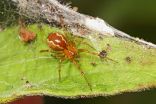(Press-News.org) MINNEAPOLIS – Women who are anxious, jealous, or moody and distressed in middle age may be at a higher risk of developing Alzheimer's disease later in life, according to a nearly 40-year-long study published in the October 1, 2014, online issue of Neurology®, the medical journal of the American Academy of Neurology.
"Most Alzheimer's research has been devoted to factors such as education, heart and blood risk factors, head trauma, family history and genetics," said study author Lena Johannsson, PhD, of the University of Gothenburg in Gothenburg, Sweden. "Personality may influence the individual's risk for dementia through its effect on behavior, lifestyle or reactions to stress."
For the study, 800 women with an average age of 46 were followed for 38 years and given personality tests that looked at their level of neuroticism and extraversion or introversion, along with memory tests. Of those, 19 percent developed dementia.
Neuroticism involves being easily distressed and personality traits such as worrying, jealousy or moodiness. People who are neurotic are more likely to express anger, guilt, envy, anxiety or depression. Introversion is described as shyness and reserve and extraversion is associated with being outgoing.
The women were also asked if they had experienced any period of stress that lasted one month or longer in their work, health, or family situation. Stress referred to feelings of irritability, tension, nervousness, fear, anxiety or sleep disturbances. Responses were categorized as zero to five, with zero representing never experiencing any period of stress, to five, experiencing constant stress during the last five years. Women who chose responses from 3 and 5 were considered to have distress.
The study found that women who scored highest on the tests for neuroticism had double the risk of developing dementia compared to those who scored lowest on the tests. However, the link depended on long-standing stress.
Being either withdrawn or outgoing did not appear to raise dementia risk alone, however, women who were both easily distressed and withdrawn had the highest risk of Alzheimer's disease in the study. A total of 16 of the 63 women, or 25 percent, who were easily distressed and withdrawn developed Alzheimer's disease, compared to eight out of the 64 people, or 13 percent, of those who were not easily distressed and were outgoing.
INFORMATION:
The study was supported by the Swedish Medical Research Council, the Swedish Council for Working Life and Social Research, the Swedish Research Council for Health, Working Life and Welfare, the Alzheimer's Association, the Bank of Sweden Tercentenary Foundation, Swedish Brain Power, Söderström - Königska Nursing Home Foundation, Gamla Tjänarinnor Foundation, Shopkeeper Hjalmar Svensson's Research Foundation, Professor Bror Gadelius Memorial Foundation the Dementia Foundation, Fredrik and Ingrid Thurings Foundation and the University of Gothenburg.
To learn more about dementia, please visit http://www.aan.com/patients.
The American Academy of Neurology, an association of 28,000 neurologists and neuroscience professionals, is dedicated to promoting the highest quality patient-centered neurologic care. A neurologist is a doctor with specialized training in diagnosing, treating and managing disorders of the brain and nervous system such as Alzheimer's disease, stroke, migraine, multiple sclerosis, brain injury, Parkinson's disease and epilepsy.
For more information about the American Academy of Neurology, visit http://www.aan.com or find us on Facebook, Twitter, Google+ and YouTube.
Media Contacts:
Rachel Seroka, rseroka@aan.com, (612) 928-6129
Michelle Uher, muher@aan.com, (612) 928-6120
Worry, jealousy, moodiness linked to higher risk of Alzheimer's in women
2014-10-01
ELSE PRESS RELEASES FROM THIS DATE:
Hypertension risk rises closer to major roadways
2014-10-01
PROVIDENCE, R.I. [Brown University] — A new study in the Journal of the American Heart Association reports a significant association between living near a major roadway and the risk of high blood pressure.
The Brown University-led analysis of data from 5,400 post-menopausal women in the San Diego metropolitan area found that women who lived within 100 meters of a highway or major arterial road had a 22-percent greater risk of hypertension than women who lived at least 1,000 meters away. In a range of intermediate distances, hypertension risk rose with proximity to the ...
Hospitals with aggressive treatment styles had lower failure-to-rescue rates
2014-10-01
Hospitals with aggressive treatment styles, also known as high hospital care intensity (HCI), had lower rates of patients dying from a major complication (failure to rescue) but longer hospitalizations, writes Kyle H. Sheetz, M.D., M.S., of the Center for Healthcare Outcomes and Policy, Ann Arbor, Mich., and colleagues.
The intensity of medical care varies around the country. Intensity is synonymous with an aggressive treatment style and it has been implicated in rising health care costs, especially during the end-of-life period. Inpatient surgery also is a cost burden. ...
Montmorency tart cherry juice lowered blood uric acid levels and a marker for inflammation
2014-10-01
LANSING, Mich. October 1, 2014 – Tart cherries have long been researched for their association with pain relief – ranging from gout and arthritis joint pain to exercise-related muscle pain. A new study published in the Journal of Functional Foods is the first to report consumption of Montmorency tart cherries caused changes in uric acid metabolism, which can have an impact on joint pain. The study also detected increases in specific anthocyanin compounds in the bloodstream after consuming tart cherries.
In the study, Montmorency tart cherry juice reduced blood levels ...
UMN research pinpoints microRNA tied to colon cancer tumor growth
2014-10-01
MINNEAPOLIS/ST PAUL (October 1, 2014) – Researchers at the University of Minnesota have identified microRNAs that may cause colon polyps from turning cancerous. The finding could help physicians provide more specialized, and earlier, treatment before colon cancer develops.
The findings are published today in The Journal of Pathology.
The American Cancer Society estimates over 134,000 people will be diagnosed with colon cancer in 2014, despite the expanded screening processes now available. This year alone, about 50,000 people will die because of the disease.
Research ...
Fibromyalgia and the role of brain connectivity in pain inhibition
2014-10-01
New Rochelle, NY, October 1, 2014—The cause of fibromyalgia, a chronic pain syndrome is not known. However, the results of a new study that compares brain activity in individuals with and without fibromyalgia indicate that decreased connectivity between pain-related and sensorimotor brain areas could contribute to deficient pain regulation in fibromyalgia, according to an article published in Brain Connectivity, a peer-reviewed journal from Mary Ann Liebert, Inc., publishers. The article is available free on the Brain Connectivity website at http://online.liebertpub.com/doi/full/10.1089/brain.2014.0274 ...
Spiders: Survival of the fittest group
2014-10-01
Along rivers in Tennessee and Georgia, scientists have been studying brownish-orange spiders, called Anelosimus studiosus, that make cobwebby nests "anywhere from the size of a golf ball to the size of a Volkswagen Beetle," researcher Jonathan Pruitt says. The individual spiders are only the size of a pencil eraser, but they form organized groups that can catch prey ranging from fruit flies to small vertebrates. "We have found carcasses of rats and birds inside their colonies," Pruitt says. Unlike most spiders, which are solitary, these social spiders work together in groups.
Now ...
New molecule fights oxidative stress; May lead to therapies for cancer and Alzheimer's
2014-10-01
COLUMBIA, Mo. – Breathing oxygen helps the body create energy for its cells. As a result of the breathing process, reactive molecules called "free radicals" are produced that often cause damage to proteins and genes found in cells. This damage is known as oxidative stress. Free radicals also have been linked to cancer, Alzheimer's and Parkinson's disease. Now, investigators at the University of Missouri have discovered a molecule that treats oxidative stress.
"Oxidative stress can cause damage to the building blocks of a cell, resulting in excessive cell proliferation, ...
Decreased ability to identify odors can predict death
2014-10-01
For older adults, being unable to identify scents is a strong predictor of death within five years, according to a study published October 1, 2014, in the journal PLOS ONE. Thirty-nine percent of study subjects who failed a simple smelling test died during that period, compared to 19 percent of those with moderate smell loss and just 10 percent of those with a healthy sense of smell.
The hazards of smell loss were "strikingly robust," the researchers note, above and beyond most chronic diseases. Olfactory dysfunction was better at predicting mortality than a diagnosis ...
AAO-HNSF clinical practice guideline: Tinnitus
2014-10-01
ALEXANDRIA, VA — The American Academy of Otolaryngology—Head and Neck Surgery Foundation has released the first ever mutli-disciplinary, evidence-based clinical practice guideline to improve the diagnosis and management of tinnitus, the perception of sound—often ringing—without an external sound source. The guideline was published today in the journal Otolaryngology–Head and Neck Surgery.
"Tinnitus affects 10-15% of adults in the United States. It is the most common service-related disability among our military veterans. Yet despite its prevalence and effect on quality ...
Decreased ability to identify odors may predict 5-year mortality
2014-10-01
For older adults, being unable to identify scents may be a predictor of mortality within five years, according to a study published October 1, 2014, in the journal PLOS ONE by Jayant Pinto from The University of Chicago and colleagues.
The study was part of the National Social Life, Health and Aging Project (NSHAP), the first in-home study of social relationships and health in a large, nationally representative sample of men and women ages 57 to 85. Researchers first surveyed 3,000 participants in 2005-06, assessing their ability to identify five distinct common odors, ...





